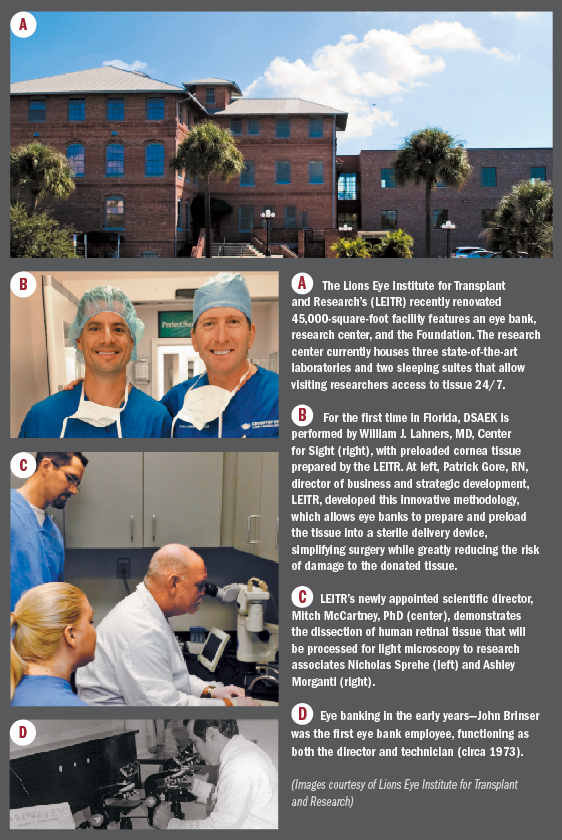Article
Lions Eye Institute for Transplant & Research turns 40
While marking its 40th anniversary this year, the LEITR recognized its many achievements while also laying out its plans moving forward.
Take Home
While marking its 40th anniversary this year, the LEITR recognized its many achievements while also laying out its plans moving forward.

Woody
By Beth Thomas Hertz
Tampa, FL-The Lions Eye Institute for Transplant & Research (LEITR)-the only combined eye bank and ocular research center in the world-marked its 40th anniversary this summer with a celebration where its leaders reviewed the organization’s successes and laid out its vision for the future.
A gala ball was held in November as part of the ongoing celebration as well.
According to the LEITR, as of the July anniversary, it has brought the “gift of sight” to more than 58,000 men, women, and children worldwide since Lions Club International members formed it in 1973.
That number is expected to be close to 62,000 by the end of 2013, said Jason Woody, president and Chief executive officer of LEITR.
History
The institute was formed by a group of local Lions members, an organization that was asked by Helen Keller to be “knights against blindness,” Woody said.
Lions members were already known for their work providing items such as eyeglasses and guide dogs, but the Tampa group decided to expand its mission into creating an eye bank, he said.
Starting in a small facility at the University of South Florida-with one employee, John Brinser, and help from local ophthalmologist Dr. William Edwards who did the retrievals in his after-office hours-LEITR facilitated 30 transplants its first year.
By 1975, Dr. Edwards was serving as the medical director for the growing organization.
The organization moved into increasingly larger space over the years, and today is housed in a 45,000-square-foot renovated facility that formerly housed a cigar factory in the Ybor City area of Tampa.
Along the way, it made a commitment to being a leading research center as well as an eye bank, Woody said. Today, both functions share the space and the donated tissue.
“Having our eye bank and ocular research center located in the same building has been an invaluable differentiator for our organization,” he said. “This model allows researchers 24/7 access to ocular tissue, which means better results for research and transplantation.”
It also lets LEITR work on two fronts-saving sight today and looking for ways to save it in the future, he said.

New scientific director
LEITR welcomed its first scientific director, Mitch McCartney, PhD-a 25-year veteran of the ophthalmic pharmaceutical industry-in September. He previously led research initiatives within Alcon Laboratories Inc., where he set up the electron microscopy unit and integrated it into their research process, and the Novartis Institutes for Biomedical Research.
His primary mission, Dr. McCartney said, is to further develop the research initiatives that have been started at LEITR.
“We have worked with local universities for a number of years, but I am charged with taking this work to the next level, operating our own independent program and enhancing our collaborations with many organizations,” he said.
Dr. McCartney outlined three long-term initiatives that are under way:
· As part of its mission in providing tissue samples to other organizations, LEITR would like to enhance the tissue’s potential by performing initial model steps on the tissue in-house. For example, he said, the institute might complete steps A, B, and C of a research model before sending the tissue to the collaborators who have the capacity to do more advanced work with the sample due to having made a large capital investment in technology such as mass spectroscopy. “Our work enables the sample to get into model systems more quickly,” Dr. McCartney said.
· Create a biorepository in which it would freeze, embed in paraffin, and document certain aspects of healthy and diseased donor tissue by photography as well as genotyping the specimen. A blood sample and donor history will be incorporated into the repository as well. By offering well-characterized tissue samples, the institute will help researchers identify new insights into the disease process, he said.
· Establish its own basic science research program to further both bench science and corneal transplant surgeons’ clinical needs.
“LEITR has made some significant research strides over the past years and I believe that is just the beginning,” Dr. McCartney said. “I was very interested in this job because I enjoy building research programs and because this institute has the potential to help the research community do better science and help improve their model systems by using human ocular tissue.”
Future plans

Dr. McCartney
Dr. McCartney noted LEITR’s recent two large, groundbreaking research developments, which included the completion of pre-loaded EndoGlide cartridges that will make corneal surgeries more efficient.
He also said LEITR’s work in helping show that the pharmacological dilation of pupils is possible after death will be useful in evaluating eyes with limited clinical history and open windows for research of various ocular diseases.
Foundation Director Kelley Sims stressed the foundation’s success in donating nearly $1 million annually in needed eye tissue to help blind and visually impaired people throughout the world.
Because of gifts designated specifically for research, the foundation has also set aside more than $125,000 for future scientific projects, he said.
Woody also announced that in the next year, LEITR would invest more than $300,000 in staff and equipment to make its laboratory state of the art.
“We intend to be the new pioneers of ocular research,” he said.
Possible box:
For more information
To learn more about the Lions Eye Institute for Transplant & Research, visit www.lionseyeinstitute.org or contact info@LionsEyeInstitute.org.
Another possible box:
LEITR Milestones
-1973: Created
-1973-1993: Provided 11,205 corneas for transplant
-1994-2004: Provided nearly 20,000 corneas for transplant, nearly doubling previous 20-year total, in just 10 years
-2004-2012: Provided 27,543 corneas for transplant
Subscribe to Ophthalmology Times to receive the latest clinical news and updates for ophthalmologists.
Newsletter
Don’t miss out—get Ophthalmology Times updates on the latest clinical advancements and expert interviews, straight to your inbox.




